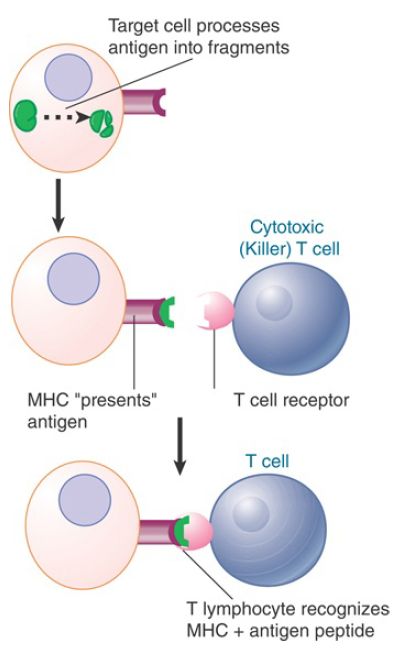
Adaptive Immunity
 المؤلف:
JOCELYN E. KREBS, ELLIOTT S. GOLDSTEIN and STEPHEN T. KILPATRICK
المؤلف:
JOCELYN E. KREBS, ELLIOTT S. GOLDSTEIN and STEPHEN T. KILPATRICK
 المصدر:
LEWIN’S GENES XII
المصدر:
LEWIN’S GENES XII
 الجزء والصفحة:
الجزء والصفحة:
 28-4-2021
28-4-2021
 2654
2654
Adaptive Immunity
- Antigen-specific B and T lymphocytes underpin adaptive immunity.
- B cells produce antibodies (immunoglobulins, Ig). Antibodies possess diverse biological effector functions to eliminate pathogens through binding of specific antigens.
Th cells direct B cells for optimal antibody responses; cytotoxic T cells (CTLs) kill pathogen-infected host cells. These effector T cells are activated by TCR recognition of an antigenic peptide complexed with a major histocompatibility complex (MHC) molecule on the target cell.
The defining critical feature of adaptive immunity is the specificity for antigens, such as those expressed by bacteria and viruses. This is made possible by the specificity of the BCRs and TCRs expressed on B and T lymphocytes, respectively. BCRs and TCRs are related in structure and their genes are related in organization. The mechanism underlying the variability is also similar (i.e., gene recombination).
Specific recognition and binding of an antigen by the BCRs expressed on the surface of B cells triggers B cell activation, proliferation, and differentiation, leading to the production of large amounts of antibodies specific for the same antigen. The structure and antigenic specificity (epitope) of the antibody produced by a given B cell are identical to those of the BCRs borne on the same B cell. Antibodies recognize naturally occurring proteins, glycoprotein, carbohydrates, or phospholipids, such as structural components of bacteria and viruses or bacterial toxins (FIGURE 1). Binding of antigen by antibody gives rise to an antigen–antibody complex, which, in turn, triggers the activation of soluble mediators and phagocytic cells (mainly macrophages) that eventually lead to the disruption of the antibody-bound bacterium or virus. A major soluble mediator is complement, a multiprotein/enzymatic cascade, whose name reflects its ability to “complement” the action of the antibody itself. Complement consists of a set of more than 20 proteins that function through a proteolytic cascade. If the target antigen is part of a cell—for example, an infecting bacterium—the action of complement culminates in the lysis of the bacterium. The activation of complement also releases proinflammatory soluble mediators and chemotactic mediators; that is, molecules that can attract phagocytic cells, such as macrophages and granulocytes, which scavenge the target cells or their products. Complement is also an important innate immune mediator, integrating the innate and adaptive immune functions when activated by an antibody.
Antibody-coated bacteria may also be directly killed by macrophages (scavenger cells) that are recruited by the antigen– antibody complex.

FIGURE 1. Free antibodies bind to antigens to form antigen– antibody complexes that are removed from the bloodstream by macrophages or are attacked directly by the activated complement cascade.
T cells are activated upon TCR recognition of peptide fragments derived from a foreign antigen. A crucial feature of TCR recognition is that the antigen must be presented in conjunction with a major histocompatibility complex (MHC) molecule, which is expressed by an antigen-presenting cell (APC). The MHC possesses a groove on its surface that binds a peptide fragment derived from the foreign antigen. The TCR recognizes the combination of a peptide fragment and MHC protein. The requirement that T lymphocytes recognize (foreign) antigen in the context of (self) MHC protein ensures that the cell-mediated response acts only on host cells that have been infected with a foreign antigen. MHC proteins also share some common features with antibodies, as do other lymphocyte-specific proteins; the immune system relies on a series of superfamilies of genes that may have evolved from common ancestors encoding primitive defense elements.
Each individual has a characteristic set of MHC proteins that fall into the general clusters of class I and class II, which restrict the activation of Th cells and cytotoxic T cells (CTLs), respectively.
Th cells are activated by APCs, such as DCs and B lymphocytes. Cognate interactions of T and B cells activated by the same antigen allow the engagement of the CD40 receptor expressed on
B cells by the CD40 ligand (also called CD154) expressed on T cells. CD40 ligation, together with the exposure to cytokines produced by Th cells and other immune cells, induces B cells to undergo optimal proliferation and differentiation. In contrast to Th cells, CTLs, or killer T cells, mediate responses that kill host cells infected by an intracellular parasite, such as a virus (FIGURE 2).

FIGURE 2. In cell-mediated immunity, cytotoxic T cells use the T cell receptor (TCR) to recognize a peptide fragment of the antigen that is presented on the surface of the target cell by the MHC molecule.
 الاكثر قراءة في مواضيع عامة في الاحياء الجزيئي
الاكثر قراءة في مواضيع عامة في الاحياء الجزيئي
 اخر الاخبار
اخر الاخبار
اخبار العتبة العباسية المقدسة


